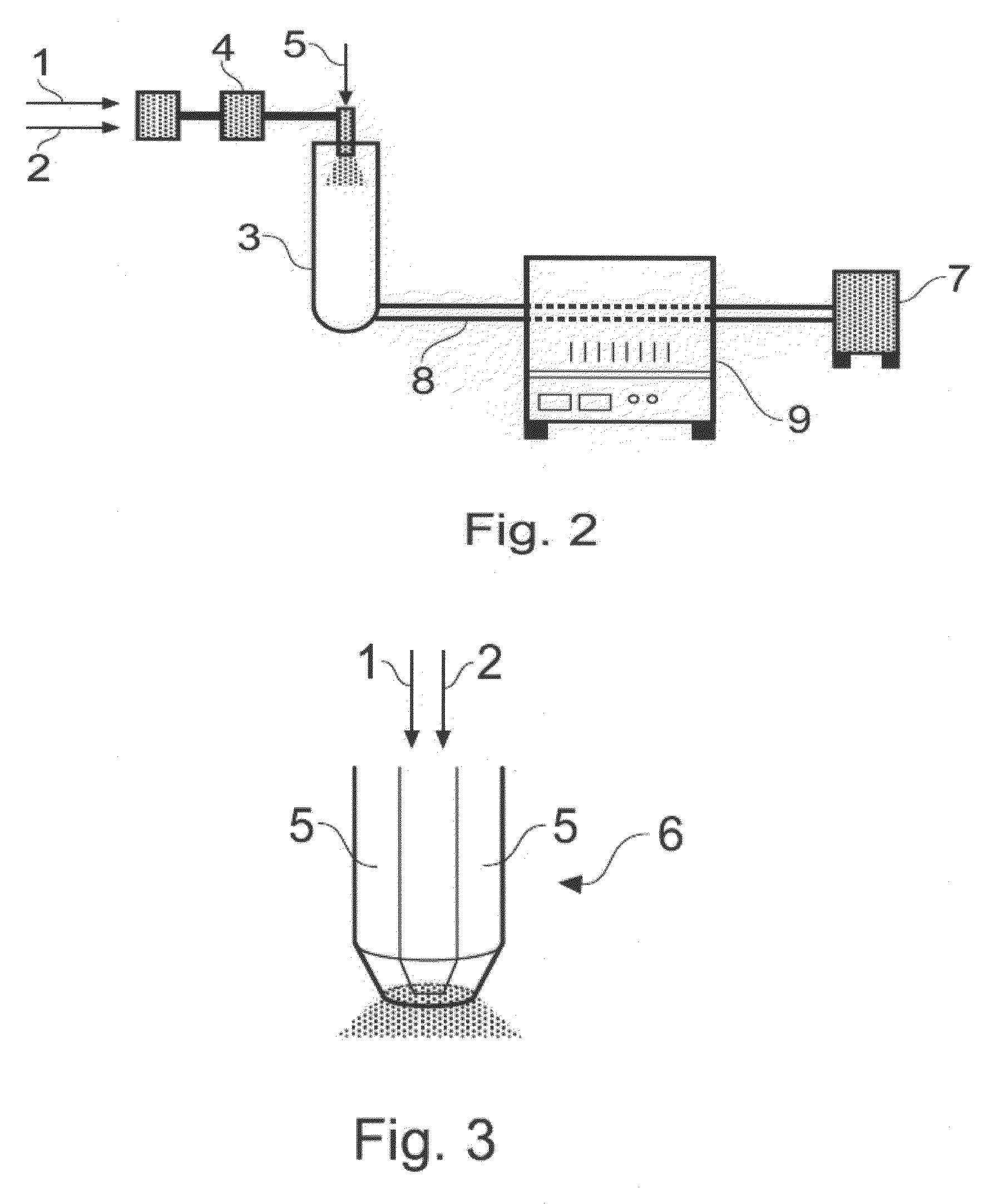Spray-drying process for the manufacture of dye-loaded particlesä
a technology of dye-loaded particles and spray drying process, which is applied in the field of process for the preparation of encapsulated dyes and to encapsulated dyes, can solve the problems of dye leakage of particles made according to the processes described in these documents
- Summary
- Abstract
- Description
- Claims
- Application Information
AI Technical Summary
Benefits of technology
Problems solved by technology
Method used
Image
Examples
example 1
Preparation of Silica loaded with Tartrazine (FD&C Yellow No. 5)
[0061]As a first step to synthesising sodium tartrazine-containing silica, the dye (commercially available from Sigma as T0388-100G (CAS# 1934-21-0) was ion-exchanged using a column with ion-exchanging resin (type Dowex 50Wx8 commercially available Dow Chemical Comp., Michigan, USA. This was necessary because the use of commercial Tartrazine induces flocculation of the tetraethylorthosilicate / ethanol / hydrochloric acid (TEOS / EtOH / HCl) encapsulating agent mixture.
Column Preparation
[0062]The column was loaded with 317 g Dowex 50Wx8 to obtain a 400 ml bed volume.
Step 1—Washing: to remove residual sodium cations, the column was eluted with 2.5 l deionized water over 5 to 10 minutes at pH 6.
Step 2—Reconditioning: to remove bound sodium cations the column was washed through with four batches of 400 ml 7% HCl. The contact time of HCl on the column was 45 minutes.
Step 3—Washing: as for Step 1.
[0063]Step 4—Charging: as for Step 2...
example 2
Preparation of Silica loaded with Amaranth (Acid Red No. 27)
[0071]This red dye is soluble in water but it is not soluble in ethanol. It was not necessary to ion-exchange the aqueous solution (as was done for Tartrazine in Example 1), however, as it did not flocculate when it was blended with the TEOS mixture. Also, even though the dye was insoluble in ethanol, it was still possible to use it directly by increasing the water proportion in the aerosol mixture.
[0072]Two batches of coloured silica were prepared using 10.4 g TEOS, 5.4 g of HCl of pH 2 and 12.0 g of ethanol. The components were mixed together and the mixture was left stirring for 30 minutes. Theoretically, the mixture would give 3 g of silica after the aerosolisation. Thus, the calculation of the amount of Amaranth solution (obtained from Sigma has catalogue number A1016-100G (CAS#915-67-3)) to add was based on this amount of silica. This was as follows: 0.3 g of Amaranth powder plus 10.0 g of HCl (pH 2)...
example 3
Preparation of Silica loaded with Erioglaucine (FD & C Blue No. 1)
[0073]This blue dye is soluble in water and ethanol and it was not necessary to ion exchange the solution.
[0074]Two batches of coloured silica were prepared each using 10.4 g TEOS, 5.4 g HCl (pH2) and 8.0 g of ethanol. The components were mixed together and the mixture was left under stirring for 30 minutes. Theoretically, the mixture would give 3 g of silica after the aerosolisation. Thus, the calculation of the amount of Erioglaucine solution to add was based on this amount of silica. This was as follows: 0.3 g of Erioglaucine powder (obtained from Sigma / Aldrich, catalogue# 861146-25G (CAS#3844-45-9)) plus 2.0 g of HCl (pH 2) in 3 g ethanol. The two mixtures were mixed together and left to stir for 10 minutes. The mixture was subsequently spray dried, heated, washed, the particles separated and size measured as in example 1. The particle size results are shown in FIG. 4c, and:
d(0.1): 0.327 μm
d(0.5)...
PUM
| Property | Measurement | Unit |
|---|---|---|
| Temperature | aaaaa | aaaaa |
| Temperature | aaaaa | aaaaa |
| Acidity | aaaaa | aaaaa |
Abstract
Description
Claims
Application Information
 Login to View More
Login to View More - R&D
- Intellectual Property
- Life Sciences
- Materials
- Tech Scout
- Unparalleled Data Quality
- Higher Quality Content
- 60% Fewer Hallucinations
Browse by: Latest US Patents, China's latest patents, Technical Efficacy Thesaurus, Application Domain, Technology Topic, Popular Technical Reports.
© 2025 PatSnap. All rights reserved.Legal|Privacy policy|Modern Slavery Act Transparency Statement|Sitemap|About US| Contact US: help@patsnap.com



